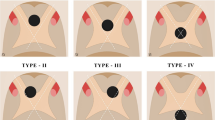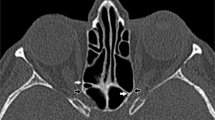Abstract
Pituitary adenomas can expand upward through the foramen diaphragma sellae (FDS), compress the visual pathways on the suprasellar region, and cause diverse visual defects. However, the relationship between the FDS and the visual pathway has not been thoroughly clarified. This study was thus performed to determine the topographic relationship between these two structures. One hundred heads of adult cadavers were examined in this study. The FDS was classified into five types (Ia, Ib, Ic, II, and III) according to its location relative to the four parts of suprasellar region of the visual pathways. The midpoint of the optic chiasm (OC) was located on the midline passing through the crista galli in 70% of cases, but to the left and right sides of the midline in 9 and 21% of cases, respectively. The FDS was completely covered by OC in 30% of the cases, but it was partly seen superiorly in 70%. The pituitary infundibulum passed mainly through the center middle or posterior middle part of nine partitions of the FDS. The horizontal and vertical diameters of the foramen were 7.9 ± 2.0 and 7.6 ± 1.9 mm, respectively. The length of the optic nerve was 9.7 ± 1.9 mm on the left side and 9.5 ± 1.9 mm on the right side. The angle between the optic nerve and the midline was 34.5° ± 5.7° on the left side and 36.0° ± 6.3° on the right side. The results of this study are expected to further the current knowledge of the topographic anatomy on suprasellar structures.





Similar content being viewed by others
References
Campero A, Martins C, Yasuda A et al (2008) Microsurgical anatomy of the diaphragma sellae and its role in directing the pattern of growth of pituitary adenomas. Neurosurgery 62:717–723
Clemente CD (1985) Gray’s anatomy, 30th edn. Lea & Febiger, Philadelphia
Elliott R, Hsieh K, Hochman T et al (2010) Efficacy and safety of radical resection of primary and recurrent craniopharyngiomas in 86 children. J Neurosurg Pediatr 5:30–48
Ferreri AJM, Garrido SA, Markarian MG, Yañez A (1992) Relationship between the development of diaphragma sellae and the morphology of the sella turcica and its content. Surg Radiol Anat 14:233–239
Gibo H, Lenkey C, Rhoton AL Jr (1981) Microsurgical anatomy of the supraclinoid portion of the internal carotid artery. J Neurosurg 55:560–574
Hollenhorst RW, Younge BR (1973) Ocular manifestations produced by adenomas of the pituitary gland: analysis of 1000 cases. In: Kohler P, Ross GT (eds) Diagnosis and treatment of pituitary tumors. Elsevier, New York, pp 53–64
Renn W, Rhoton AL Jr (1975) Microsurgical anatomy of the sellar region. J Neurosurg 43:288–298
Rosse C, Gaddum-Rosse P (1997) Hollinshead’s textbook of anatomy, 5th edn. Lippincott-Raven, Philadelphia
Sage MR, Blumbergs PC, Mulligan BP et al (1982) The diaphragma sellae: its relationship to the configuration of the pituitary gland. Radiology 145:703–708
Standring S (2008) Intracranial region. In: Standring S, Borley NR, Collins P, Crossman AR, Gatzoulis MA, Healy JC, Johnson D, Mahadevan V, Newell RLM, Wigley CB (eds) Gray’s anatomy, 40th edn. Churchill Livingstone, New York, pp 423–434
Wang KC, Kim SK, Choe G et al (2002) Growth patterns of craniopharyngioma in children: role of the diaphragma sellae and its surgical implication. Surg Neurol 57:25–33
Acknowledgment
This study was supported by Samsung Biomedical Research Institute (Grant No. B-A9-203-1). The authors thank Mr. Seong-In John for help in the preparation of illustrations.
Author information
Authors and Affiliations
Corresponding author
Rights and permissions
About this article
Cite this article
Won, HS., Han, SH., Oh, CS. et al. Topographic variations of the optic chiasm and the foramen diaphragma sellae. Surg Radiol Anat 32, 653–657 (2010). https://doi.org/10.1007/s00276-010-0661-1
Received:
Accepted:
Published:
Issue Date:
DOI: https://doi.org/10.1007/s00276-010-0661-1




